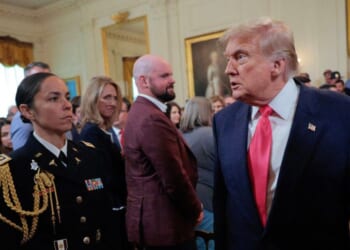While the mainstream media talking heads pontificate about Trump’s economy being in freefall, the labor market just keeps moving along. The latest jobs report from the Bureau of Labor Statistics shows solid growth for April, defying Democrats’ apocalyptic predictions, though there are admittedly signs of stress from the trade war, and Americans should take notice.
In short, the April jobs report was neither great nor terrible, but positive overall. For instance, the headline figure of 177,000 payrolls added was much higher than expectations, but that’s because previous months were revised down. Accounting for those revisions shows 119,000 additional payrolls, which is more in line with most forecasts.
This is still solid job growth, especially when coupled with data from the survey of households showing the number of people employed jumped 436,000 for the month. More than half a million people joined the labor force, a surge that was mostly due to folks reentering the labor market after having previously given up looking for work.
That caused the employment-to-population ratio and the labor force participation rate to both rise, pointing to a stronger labor market and greater confidence among workers. And despite the supply of workers increasing by hundreds of thousands, nearly all of them got jobs which prevented the unemployment rate from rising.
The quality of jobs added in April was just as impressive as the quantity. Nearly all the rise in payrolls came from the productive private sector, not government hiring. This is a welcomed changed from the Biden administration, which routinely buoyed the monthly jobs numbers by hiring massive numbers of federal workers.
Now, the situation is exactly the opposite. The federal government, excluding the postal service, saw its fourth monthly decrease in payrolls as Elon Musk and his DOGE crew continued identifying waste and slashing unnecessary expenses. These cuts to the federal workforce have now wiped out the Biden administration’s last nine months of increases.
Within the private sector, the job gains were widespread across most industries with two-thirds of all jobs added over the last year now being full-time work. Conversely, a disproportionate number of the jobs created under the previous administration were part-time, as folks had to take on multiple part-time jobs in addition to regular work, all to make ends meet.
But in April, fewer people needed extra jobs to supplement their income, so the number of multiple jobholders actually declined. New entrants to the labor market picked up all those jobs and then some. This is yet another positive sign that the economy is returning to a normal, and healthy, balance.
But that labor market is also showing symptoms of stress related to the ongoing tariff fight. The manufacturing sector, which has seen employment trending down since the start of 2023, saw hiring grind to a halt in April, causing the sector to lose about 1,000 jobs.
The subsectors that caused the decline were semiconductors and automotive, two segments of manufacturing hit particularly hard by the current trade war. This news isn’t isolated to just the monthly jobs report. The manufacturing surveys from the regional Federal Reserve Banks and as well as purchasing manager indexes all point to a dramatic slowdown in the sector.
The brakes have come on hard at factories because there’s simply too much uncertainty from the administration. Between Commerce Secretary Howard Lutnick, Trade Representative Jamieson Greer, and Senior Counselor Peter Navarro, the administration’s narrative is all over the place. These three have repeatedly contradicted each other, and sometimes even themselves.
And while the administration continues to carve out exemptions for tariffs, the constant policy changes and conflicting narratives have caused tremendous uncertainty, making it impossible for businesses and individuals to plan. That has chilled investment and frozen hiring in most of manufacturing.
Additionally, industry has gone on an import binge to try and front-run tariffs, bringing extra inventory and equipment into the country before those import taxes are implemented. The surge in imports created the most lopsided quarter of international trade ever, which in turn reduced economic growth by a record 4.83 percentage points, as measured by gross domestic product.
It’s imperative that the Trump administration successfully negotiate bilateral trade deals to reduce barriers to trade, shepherd tax and spending cuts through Congress, and continue eliminating burdensome overregulation. Failure to accomplish these measures will turn today’s signs of economic stress into cracks—and then collapse.
E.J. Antoni, Ph.D., is a public finance economist, the Richard F. Aster fellow at the Heritage Foundation, and a senior fellow at Unleash Prosperity.
The views and opinions expressed in this commentary are those of the author and do not reflect the official position of the Daily Caller News Foundation.
All content created by the Daily Caller News Foundation, an independent and nonpartisan newswire service, is available without charge to any legitimate news publisher that can provide a large audience. All republished articles must include our logo, our reporter’s byline and their DCNF affiliation. For any questions about our guidelines or partnering with us, please contact licensing@dailycallernewsfoundation.org.




![‘It’s a Recipe for a Hundred Years of National Dominance’: Stephen Miller [WATCH]](https://www.right2024.com/wp-content/uploads/2025/05/Stephen-Miller-Completely-Obliterates-CNN-Host-Over-Her-Illegal-Immigration-350x250.jpg)

![Trump Posts Hilarious Pope Meme, Leftists Immediately Melt Down [WATCH]](https://www.right2024.com/wp-content/uploads/2025/05/Trump-Posts-Hilarious-Pope-Meme-Leftists-Immediately-Melt-Down-WATCH-350x250.jpg)


![Mother Breaks Silence After Three Daughters Killed During Father’s Custody Visit, Memorial Held [WATCH]](https://www.right2024.com/wp-content/uploads/2025/06/Mother-Breaks-Silence-After-Three-Daughters-Killed-During-Fathers-Custody-350x250.jpg)






